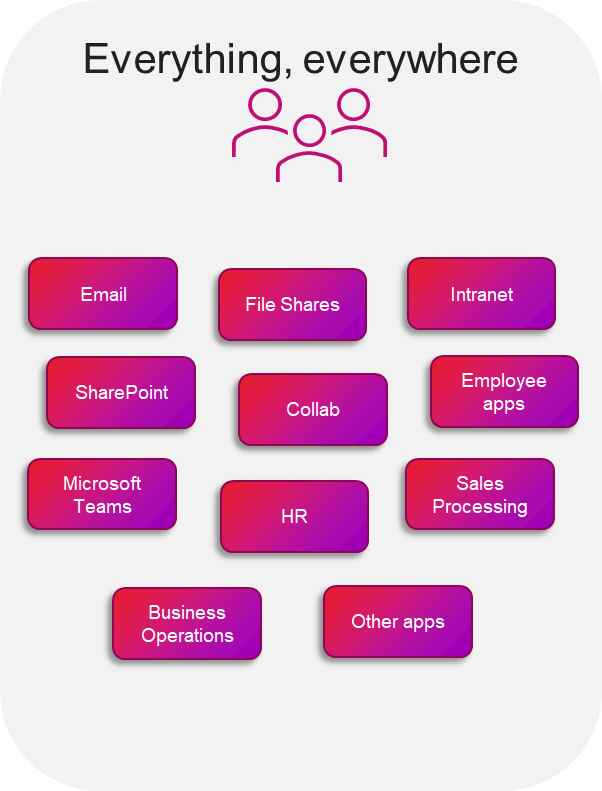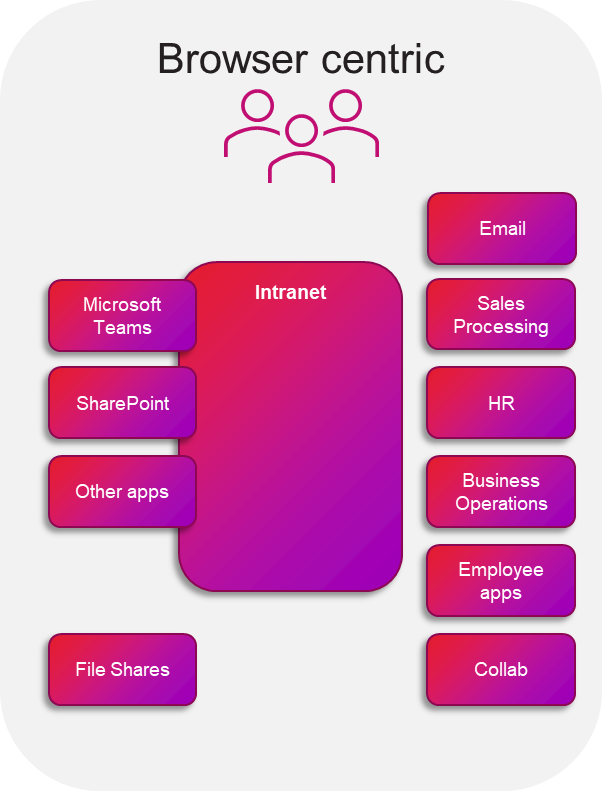Over the last two years the intranet has evolved from being a document storage facility to the hub for employees in their working lives. The rather hurried and enforced switch to remote working in March 2020, and the subsequent flow into hybrid working, has made this even more the case. In this first blog of three, we look at what an intranet is and the different ways it can be at the heart of your employee experience and your hybrid working model.
Organisations have been going through a continual cycle of change, often relating to internal comms, onboarding employees, thinking about organisational culture, and the ongoing change in technology. So where do you start?
Over the next three blogs we will introduce some concepts for the digital workplace and look at some of the building blocks that you need to have in place.
But first. What is an intranet (these days)?

There’re probably two ways of thinking about intranet, the traditional idea of what an intranet is, and then the digital workplace. Typically, there’s a bit of a journey to go between those two ideas.
A traditional intranet is generally thought to be a storage and communications channel, something to connect employees to information, people, content and services around the organisation through to a digital workplace, which has at its heart an intranet, and usually integrations with third-party platforms.
Today that is not enough. We need something that we might consider to be the ‘digital twin’ of what was the actual, real-life, in-person Office (yes, with a capital O). A place for people to go to work, to get stuff done, collaborate/chat, to consume and receive useful information. A dynamic place to be for your employees, a useful place and one that is seamlessly connected to your organisations systems and platforms.
Both those models, traditional and dynamic, are absolutely valid depending on the context of your business, how you operate in and the expectations of what you’ll be delivering to your employees. Working from home there’s a bit of a social disconnect. You don’t speak to your co-workers on a personal note very much. What businesses, and their employees want now, is the ability to chat, to engage, to work together and more, just as if you were sitting next to each in the office. They hope that tools, such as Yammer and Teams will create a bit of a social movement, a little bit more inclusion in the digital workplace, and pretty simply get people chatting and engaged.
So what is the employee experience we’re all talking about?

With the ongoing challenge of hybrid work, what we previously presented to our employees isn’t up to the job any more, and it’s made us think a bit more about these technologies.
Firstly, there is a group of technologies that we refer to as ‘everything everywhere’, because that’s how the experience feels. But if you’re the employee with all these technologies, they do not necessarily support each other, or provide any level of integration between them.
This is a highly flexible way of working. You could introduce a new technology tomorrow for your employee, just because there isn’t really any connection between the platforms and they standalone.
Now this is a model that perhaps worked much better pre-pandemic because you are able to turn to the person to your left or over the desk or catch somebody in the kitchen and ask a question about what the right platform is to use.
 In a remote working situation, you are more isolated and less able to quickly ask a colleague. You are left to yourself to deal with the technology your organisation is giving you.
In a remote working situation, you are more isolated and less able to quickly ask a colleague. You are left to yourself to deal with the technology your organisation is giving you.
Next is the role that a browser-centric intranet is able to provide; stepping into that gap and providing the navigation and support guidance the employees are going to need to find their way around what can be a pretty comprehensive set of technologies.
There might be direct integrations with apps like Teams, and links off to other platforms to bring bits of data to you from these other systems, but really all you’re providing is a browser-based ‘portal’ experience for employees to navigate their way around your technology.
 Here’s the third option. What we have started to see is the move towards using Teams and the thinking about Microsoft Teams’ user interface as a hub for teamwork. Providing this Teams-centric angle to the workplace, allows organisations to create an aspirational destination as a digital workplace solution.
Here’s the third option. What we have started to see is the move towards using Teams and the thinking about Microsoft Teams’ user interface as a hub for teamwork. Providing this Teams-centric angle to the workplace, allows organisations to create an aspirational destination as a digital workplace solution.
As most of us have done, we’re spending a lot more time using Teams, board meetings, company calls, making our way through our calendars, perhaps, maybe more formal collaborations, structured collaborations, time-bound projects. Swapping files and notes and conversations, making up knowledge as part of the pilot project or some other collaborations.
![]() Microsoft introduced the Viva suite last year. Viva aims to brings learning and knowledge management, employee insights, and, of course, the SharePoint intranet, directly into the flow of your work. In addition, the Power Platform, brings the data from those applications into your workflow, and everything sits within the same interface. So with Viva, great content, information, knowledge, search, insights and other application services are just a click away inside the single interface.
Microsoft introduced the Viva suite last year. Viva aims to brings learning and knowledge management, employee insights, and, of course, the SharePoint intranet, directly into the flow of your work. In addition, the Power Platform, brings the data from those applications into your workflow, and everything sits within the same interface. So with Viva, great content, information, knowledge, search, insights and other application services are just a click away inside the single interface.
So, there are a lot of advantages to this model and this has certainly been evidenced by the increasing inquiries that we’ve had from customers thinking about how they can use their intranet to deliver a truly digital workplace employee experience.
Sounds pretty cool, huh? How do you make it happen?
In our next blog, we will cover the common building blocks that your organisation will need to be able to deliver a successful initial platform; a system that’s going to evolve, grow and scale in a way that’s going to be manageable and useful. It will continue to drive new value inside the organisation.
In the final blog we’ll be providing insights on how you can assess whether your organisation is ready to deploy an intranet and digital workplace, that will deliver an optimal digital employee experience.
You can read blogs two and three from this series but if you’d like to take a look at how Fresh, our enterprise-class intranet solution, works with Microsoft technologies to deliver a true digital workplace, then you can Request a Demo today.